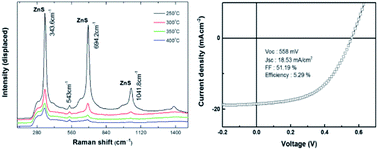Solution-processed Cu2ZnSnS4 absorbers prepared by appropriate inclusion and removal of thiourea for thin film solar cells†
Abstract
We studied how to effectively add/remove organic chemicals to/from CZTS precursor thin films to prepare uniform CZTS thin films that show optimal properties. We used multi-functional thiourea, as both a stabiliser and a source of sulphur, to prepare the precursor solutions. This is because it forms complexes with metal chlorides, which stabilise the CZTS precursor solutions and enable CZTS thin films to be spin-coated onto substrates thereby enabling fabrication of CZTS absorbers. However, the excess thiourea, required to stabilise the CZTS precursor solutions, induced the formation of a ZnS secondary phase in the CZTS thin films, which deteriorated the photovoltaic properties of the CZTS solar cells. We therefore pre-annealed the thin films to inhibit ZnS formation. We used the thiourea-stabilized CZTS precursor solutions and simple solution processing techniques to prepare CZTS precursor thin films, and optimized the pre-annealing temperature to fabricate CZTS solar cells that showed 5.29% efficiency.


 Please wait while we load your content...
Please wait while we load your content...